个人笔记
SongPinru 的小仓库
1、Spring
1.1 简介
- 春天 —>给软件行业带来了春天
- 2002年,Rod Jahnson首次推出了Spring框架雏形interface21框架。
- 2004年3月24日,Spring框架以interface21框架为基础,经过重新设计,发布了1.0正式版。
- Rod Johnson的学历 , 他是悉尼大学的博士,然而他的专业不是计算机,而是音乐学。
- Spring理念 : 使现有技术更加实用 . 本身就是一个大杂烩 , 整合现有的框架技术
官方下载地址 : https://repo.spring.io/libs-release-local/org/springframework/spring/
<!-- https://mvnrepository.com/artifact/org.springframework/spring-webmvc -->
<dependency>
<groupId>org.springframework</groupId>
<artifactId>spring-webmvc</artifactId>
<version>5.2.0.RELEASE</version>
</dependency>
<!-- https://mvnrepository.com/artifact/org.springframework/spring-jdbc -->
<dependency>
<groupId>org.springframework</groupId>
<artifactId>spring-jdbc</artifactId>
<version>5.2.0.RELEASE</version>
</dependency>
1.2 优点
- Spring是一个开源免费的框架 (容器)!
- Spring是一个轻量级的框架 , 非侵入式的
- 控制反转 IoC , 面向切面 Aop
- 对事务的支持 , 对框架整合的支持
Spring是一个轻量级的控制反转(IoC)和面向切面(AOP)的容器(框架)。
1.3 组成
Spring 框架是一个分层架构,由 7 个定义良好的模块组成。Spring 模块构建在核心容器之上,核心容器定义了创建、配置和管理 bean 的方式 .
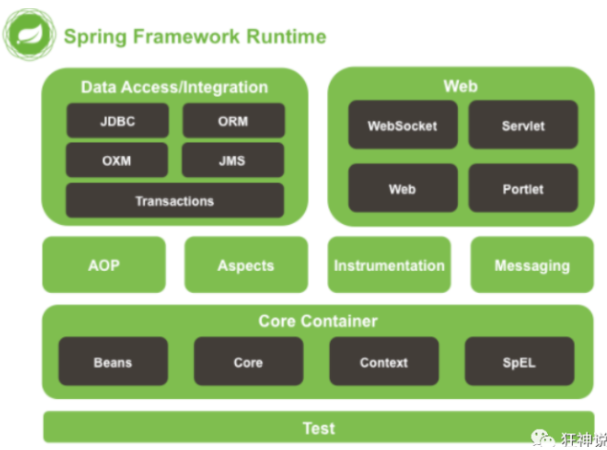
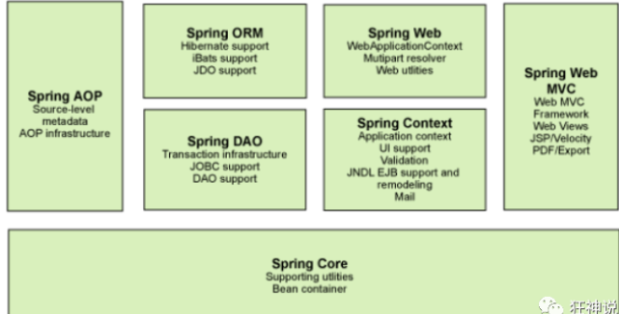
- 核心容器:核心容器提供 Spring 框架的基本功能。核心容器的主要组件是 BeanFactory,它是工厂模式的实现。BeanFactory 使用控制反转(IOC) 模式将应用程序的配置和依赖性规范与实际的应用程序代码分开。
- Spring 上下文:Spring 上下文是一个配置文件,向 Spring 框架提供上下文信息。Spring 上下文包括企业服务,例如 JNDI、EJB、电子邮件、国际化、校验和调度功能。
- Spring AOP:通过配置管理特性,Spring AOP 模块直接将面向切面的编程功能 , 集成到了 Spring 框架中。所以,可以很容易地使 Spring 框架管理任何支持 AOP的对象。Spring AOP 模块为基于 Spring 的应用程序中的对象提供了事务管理服务。通过使用 Spring AOP,不用依赖组件,就可以将声明性事务管理集成到应用程序中。
- Spring DAO:JDBC DAO 抽象层提供了有意义的异常层次结构,可用该结构来管理异常处理和不同数据库供应商抛出的错误消息。异常层次结构简化了错误处理,并且极大地降低了需要编写的异常代码数量(例如打开和关闭连接)。Spring DAO 的面向 JDBC 的异常遵从通用的 DAO 异常层次结构。
- Spring ORM:Spring 框架插入了若干个 ORM 框架,从而提供了 ORM 的对象关系工具,其中包括 JDO、Hibernate 和 iBatis SQL Map。所有这些都遵从 Spring 的通用事务和 DAO 异常层次结构。
- Spring Web 模块:Web 上下文模块建立在应用程序上下文模块之上,为基于 Web 的应用程序提供了上下文。所以,Spring 框架支持与 Jakarta Struts 的集成。Web 模块还简化了处理多部分请求以及将请求参数绑定到域对象的工作。
- Spring MVC 框架:MVC 框架是一个全功能的构建 Web 应用程序的 MVC 实现。通过策略接口,MVC 框架变成为高度可配置的,MVC 容纳了大量视图技术,其中包括 JSP、Velocity、Tiles、iText 和 POI。
1.4 拓展
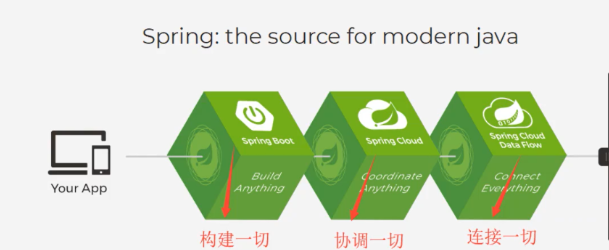
- Spring Boot
- 一个快速开发的脚手架
- 基于SpringBoot可以快速的开发单个微服务
- Spring Cloud
- Spring Cloud是基于SpringBoot实现的
2、IOC理论推导
-
UserDao 接口
public interface UserDao { public void getUser(); } -
UserDaoImpl 实现类
public class UserDaoImpl implements UserDao { @Override public void getUser() { System.out.println("获取用户数据"); } } -
UserService 业务接口
public interface UserService { public void getUser(); } -
UserServiceImpl 业务实现类
public class UserServiceImpl implements UserService { private UserDao userDao = new UserDaoImpl(); @Override public void getUser() { userDao.getUser(); } } -
测试一下
@Test public void test(){ UserService service = new UserServiceImpl(); service.getUser(); }
把Userdao的实现类增加一个 .
public class UserDaoMySqlImpl implements UserDao {
@Override
public void getUser() {
System.out.println("MySql获取用户数据");
}
}
紧接着我们要去使用MySql的话 , 我们就需要去service实现类里面修改对应的实现
public class UserServiceImpl implements UserService {
private UserDao userDao = new UserDaoMySqlImpl();
@Override
public void getUser() {
userDao.getUser();
}
}
代码量十分大,修改一次的成本十分昂贵!
我们使用一个Set接口实现,已经发生了革命性的变化!
public class UserServiceImpl implements UserService {
private UserDao userDao;
// 利用set实现
public void setUserDao(UserDao userDao) {
this.userDao = userDao;
}
@Override
public void getUser() {
userDao.getUser();
}
}
- 之前,程序是主动创建对象,控制权在程序员手上!
- 使用了set注入后,程序不再具有主动性,而是变成了被动的接受对象!
这种思想,从本质上解决了问题,我们程序员不用再去管对象的创建了。系统的耦合性大大降低,可以专注在业务的实现上!这是IOC的原型!
IOC本质
控制反转IoC(Inversion of Control),是一种设计思想,DI(依赖注入)是实现IoC的一种方法,也有人认为DI只是IoC的另一种说法。没有IoC的程序中 , 我们使用面向对象编程 , 对象的创建与对象间的依赖关系完全硬编码在程序中,对象的创建由程序自己控制,控制反转后将对象的创建转移给第三方,个人认为所谓控制反转就是:获得依赖对象的方式反转了。

采用XML方式配置Bean的时候,Bean的定义信息是和实现分离的,而采用注解的方式可以把两者合为一体,Bean的定义信息直接以注解的形式定义在实现类中,从而达到了零配置的目的。
控制反转是一种通过描述(XML或注解)并通过第三方去生产或获取特定对象的方式。在Spring中实现控制反转的是IoC容器,其实现方法是依赖注入(Dependency Injection,DI)。
3、HelloSpring
4、IOC创建对象的方式
-
使用无参构造创建对象,默认!
-
假设我们要使用有参构造创建对象。
-
下标赋值
<bean id="exampleBean" class="examples.ExampleBean"> <constructor-arg index="0" value="7500000"/> <constructor-arg index="1" value="42"/> </bean> -
构造参数类型
<bean id="exampleBean" class="examples.ExampleBean"> <constructor-arg type="int" value="7500000"/> <constructor-arg type="java.lang.String" value="42"/> </bean> -
构造参数名
<bean id="exampleBean" class="examples.ExampleBean"> <constructor-arg name="years" value="7500000"/> <constructor-arg name="ultimateAnswer" value="42"/> </bean>
-
总结:在配置文件加载的时候,容器中管理的对象就已经初始化了
5、Spring配置
5.1 别名
<!--设置别名:在获取Bean的时候可以使用别名获取-->
<alias name="userT" alias="userNew"/>
5.2 Bean的配置
<!--bean就是java对象,由Spring创建和管理-->
<!--
id : bean的标识符,要唯一,如果没有配置id,name就是默认标识符
如果配置id,又配置了name,那么name是别名
name可以设置多个别名,可以用逗号,分号,空格隔开
如果不配置id和name,可以根据applicationContext.getBean(.class)获取对象;
class : bean的全限定名=包名+类名
-->
<bean id="hello" name="hello2 h2,h3;h4" class="com.kuang.pojo.Hello">
<property name="name" value="Spring"/>
</bean>
5.2 import
这个import,一般用于团队开发使用,他可以将多个配置文件,导入合并为一个;
假设,现在项目中有多个人开发,这三个人复制不同的类开发,不同的类需要注册在不同的bean中,我们可以利用import将所有人的beans.xml合并为一个总的!
<import resource="{path}/beans.xml"/>
6、依赖注入
6.1 构造器注入
前面已经说过了
6.2 Set方式注入 【重点】
- 依赖注入:Set注入
- 依赖:bean对象的创建依赖于容器
- 注入:bean对象中的所有属性,由容器来注入
-
模拟环境搭建
-
两个实体类
@Data public class Student { private String name; private Address address; private String[] books; private List<String> hobbys; private Map<String,String> card; private Set<String> games; private String wife; private Properties info; }@Data public class Address { private String address; } -
配置 applicationContext.xml
<?xml version="1.0" encoding="UTF-8"?>
<beans xmlns="http://www.springframework.org/schema/beans"
xmlns:xsi="http://www.w3.org/2001/XMLSchema-instance"
xsi:schemaLocation="http://www.springframework.org/schema/beans
https://www.springframework.org/schema/beans/spring-beans.xsd">
<bean id="address" class="com.kuang.pojo.Address">
<property name="address" value="NJUPT9"/>
</bean>
<bean id="student" class="com.kuang.pojo.Student">
<!--第一种,普通值注入,value-->
<property name="name" value="狂神"/>
<!--第二种,Bean注入-->
<property name="address" ref="address"/>
<!--数组-->
<property name="books">
<array>
<value>红楼</value>
<value>三国</value>
</array>
</property>
<!--List-->
<property name="hobbys">
<list>
<value>music</value>
<value>swimming</value>
<value>coding</value>
</list>
</property>
<!--Map-->
<property name="card">
<map>
<entry key="身份证" value="12312121212"/>
<entry key="银行卡" value="678112121111000"/>
</map>
</property>
<!--Set-->
<property name="games">
<set>
<value>CF</value>
<value>LOL</value>
<value>GTA</value>
</set>
</property>
<!--null-->
<property name="wife">
<null/>
</property>
<!--Properties-->
<property name="info">
<props>
<prop key="学号">20190526</prop>
<prop key="username">root</prop>
<prop key="password">root</prop>
</props>
</property>
</bean>
</beans>
- 测试
public class MyTest {
public static void main(String[] args) {
ApplicationContext context = new ClassPathXmlApplicationContext("beans.xml");
Student student = (Student) context.getBean("student");
System.out.println(student);
}
}
6.3 拓展方式注入
我们可以使用p命名空间和c命名空间进行注入
官方解释:
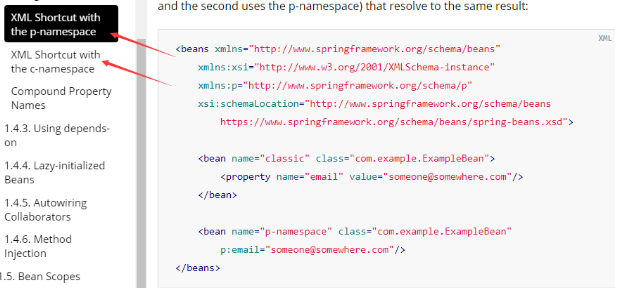
<?xml version="1.0" encoding="UTF-8"?>
<beans xmlns="http://www.springframework.org/schema/beans"
xmlns:xsi="http://www.w3.org/2001/XMLSchema-instance"
xmlns:p="http://www.springframework.org/schema/p"
xmlns:c="http://www.springframework.org/schema/c"
xsi:schemaLocation="http://www.springframework.org/schema/beans
https://www.springframework.org/schema/beans/spring-beans.xsd">
<!--p命名空间注入,可以直接注入属性的值:property-->
<bean id="user" class="com.kuang.pojo.User" p:name="狂神" p:age="18"/>
<!--c命名空间注入,通过构造器注入:construt-args-->
<bean id="user2" class="com.kuang.pojo.User" c:name="狂神2" c:age="11"/>
</beans>
注意点:p命名和c命名空间不能直接使用,需要导入xml约束!
xmlns:p="http://www.springframework.org/schema/p"
xmlns:c="http://www.springframework.org/schema/c"
6.4 Bean的作用域
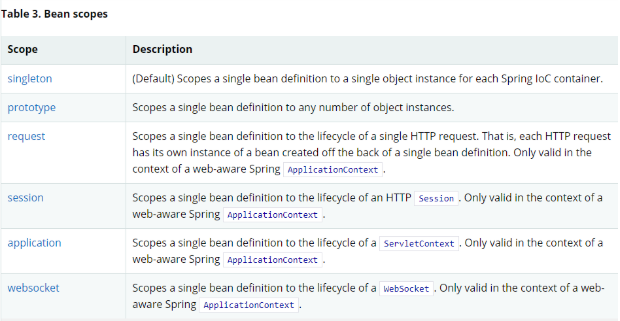
-
单例模式(Spring默认机制)
<bean id="user2" class="com.kuang.pojo.User" c:name="狂神2" c:age="11" scope="singleton"/> -
原型模式:每次从容器中get的时候,都会产生一个新对象
<bean id="user2" class="com.kuang.pojo.User" c:name="狂神2" c:age="11" scope="prototype"/> -
其余的request、session、application这些只能在web开发中使用到
7、Bean的自动装配
- 自动装配是Spring满足bean依赖的一种方式
- Spring会在上下文中自动寻找,并自动给bean装配属性
在Spring中有三种装配的方式
- 在xml中显示的配置
- 在java中显示的配置
- 隐式的自动装配bean 【重要】
7.1 测试
环境搭建:一个人有两个宠物
7.2 byName自定装配
<bean id="cat" class="com.kuang.pojo.Cat"/>
<bean id="dog" class="com.kuang.pojo.Dog"/>
<!--
byName : 会自动在容器上下文中查找,和自己对象set方法后面的值对应的bean_id
-->
<bean id="people" class="com.kuang.pojo.People" autowire="byName">
<property name="name" value="狂神"/>
</bean>
7.3 byTpye自动装配
<!--
byName : 会自动在容器上下文中查找,和自己对象set方法后面的值对应的bean_id
byType : 会自动在容器上下文中查找,和自己对象属性类型相同的bean
-->
<bean id="people" class="com.kuang.pojo.People" autowire="byType">
<property name="name" value="狂神"/>
</bean>
小结:
- byName的时候,需要保证所有bean的id唯一,并且这个bean需要和自动注入的属性的set方法的值一致
- byType的时候,需要保证所有bean的class唯一,并且这个bean需要和自动注入的属性的类型一致
7.4 使用注解实现自动装配
jdk1.5支持的注解,Spring2.5就支持注解了!
要使用注解须知:
- 导入约束
- 配置注解的支持
<?xml version="1.0" encoding="UTF-8"?>
<beans xmlns="http://www.springframework.org/schema/beans"
xmlns:xsi="http://www.w3.org/2001/XMLSchema-instance"
xmlns:context="http://www.springframework.org/schema/context"
xsi:schemaLocation="http://www.springframework.org/schema/beans
https://www.springframework.org/schema/beans/spring-beans.xsd
http://www.springframework.org/schema/context
https://www.springframework.org/schema/context/spring-context.xsd">
<context:annotation-config/>
</beans>
@Autowired
直接在属性上使用即可,也可以在set方法上使用
使用Autowired我们可以不用编写set方法了,前提是你这个自动装配的属性在 IOC(Spring)容器中存在,且符合名字byName
科普:
@Nullable 字段标记了这个注解,说明这个字段可以为null;
1
public @interface Autowired {
boolean required() default true;
}
测试代码:
public class People {
//如果显示定义了Autowired的required属性为false,说明这个对象可以为Null,否则不允许为空
@Autowired(required = false)
private Cat cat;
@Autowired
private Dog dog;
private String name;
}
如果@Autowired自动装配的环境比较复杂,自动装配无法通过一个注解【@Autowired】完成的时候,我们可以使用==@Qualifier(value = “xxx”)==去配合@Autowire的使用,指定一个唯一的bean对象注入!
public class People {
@Autowired
@Qualifier(value = "cat2")
private Cat cat;
@Autowired
private Dog dog;
private String name;
}
@Resource
public class People {
@Resource( name = "cat3")
private Cat cat;
@Resource
private Dog dog;
private String name;
}
小结:
@Resource和@Autowired的区别:
- 都是用来自动转配的,都可以放在属性字段上
- @Autowired 是通过byType的方式实现,而且必须要求这个对象存在!【常用】
- @Resource 默认通过byName的方式实现,如果找不到名字,则通过byType实现!如果两个都找不到的情况下,就报错!【常用】
- 执行顺序不同: @Autowired 通过byType的方式实现。@Resource默认通过byName的方式实现。
8. 使用注解开发
在spring4之后,必须要保证aop的包导入
使用注解需要导入contex的约束
<?xml version="1.0" encoding="UTF-8"?>
<beans xmlns="http://www.springframework.org/schema/beans"
xmlns:xsi="http://www.w3.org/2001/XMLSchema-instance"
xmlns:context="http://www.springframework.org/schema/context"
xsi:schemaLocation="http://www.springframework.org/schema/beans
https://www.springframework.org/schema/beans/spring-beans.xsd
http://www.springframework.org/schema/context
https://www.springframework.org/schema/context/spring-context.xsd">
<context:annotation-config/>
</beans>
- 属性如何注入
@Component
public class User {
@Value("dong")
private String name;
public String getName() {
return name;
}
public void setName(String name) {
this.name = name;
}
}
- 衍生的注解
@Component有几个衍生注解,会按照web开发中,mvc架构中分层。
- dao (@Repository)
- service(@Service)
- controller(@Controller)
这四个注解功能一样的,都是代表将某个类注册到容器中
- 作用域
@Scope(“singleton”)
@Component
@Scope("prototype")
public class User {
@Value("dong")
private String name;
public String getName() {
return name;
}
public void setName(String name) {
this.name = name;
}
}
小结:
xml与注解
- xml更加万能,维护简单
- 注解,不是自己的类,使用不了,维护复杂
最佳实践:
- xml用来管理bean
- 注解只用来完成属性的注入
<?xml version="1.0" encoding="UTF-8"?>
<beans xmlns="http://www.springframework.org/schema/beans"
xmlns:xsi="http://www.w3.org/2001/XMLSchema-instance"
xmlns:context="http://www.springframework.org/schema/context"
xsi:schemaLocation="http://www.springframework.org/schema/beans
https://www.springframework.org/schema/beans/spring-beans.xsd
http://www.springframework.org/schema/context
https://www.springframework.org/schema/context/spring-context.xsd">
<context:annotation-config/>
<!--指定要扫描的包-->
<context:component-scan base-package="com.pojo"/>
</beans>
9. 使用java方式配置spring
JavaConfig
Spring的一个子项目,在spring4之后,,他成为了核心功能
@Configuration //这个也会被spring容器托管,注册到容器中,因为他本来就是一个@Component
@ComponentScan("com.pojo")
@Import(Config2.class)
public class MyConfig {
@Bean
public User getUser(){
return new User();
}
}
@Component
public class User {
@Value("dong")
private String name;
public String getName() {
return name;
}
public void setName(String name) {
this.name = name;
}
@Override
public String toString() {
return "User{" +
"name='" + name + '\'' +
'}';
}
}
这种纯java配置方式
在springboot中,随处可见
10. 动态代理
动态代理和静态代理
角色一样
动态代理类是动态生成的,不是我们直接写好的!
动态代理:基于接口,基于类
- 基于接口:JDK的动态代理【使用】
- 基于类:cglib
- java字节码
InvocationHandler
Proxy
import java.lang.reflect.InvocationHandler;
import java.lang.reflect.Method;
import java.lang.reflect.Proxy;
//会这个类,自动生成代理类
public class ProxyInvocation implements InvocationHandler {
//被代理的接口
private Rent rent;
public void setRent(Rent rent) {
this.rent = rent;
}
//生成代理类
public Object getProxy(){
return Proxy.newProxyInstance(this.getClass().getClassLoader(),rent.getClass().getInterfaces(),this);
}
//处理代理实例,并返回结果
public Object invoke(Object proxy, Method method, Object[] args) throws Throwable {
seeHouse();
Object result = method.invoke(rent, args);
fare();
return result;
}
public void seeHouse(){
System.out.println("see house");
}
public void fare(){
System.out.println("fare");
}
}
public interface Rent {
void rent();
}
public class Host implements Rent {
public void rent() {
System.out.println("host rent");
}
}
public class Client {
public static void main(String[] args) {
//真实角色
Host host = new Host();
//代理角色
ProxyInvocation proxyInvocation = new ProxyInvocation();
//通过调用程序处理角色来处理我们要调用的接口对象
proxyInvocation.setRent(host);
Rent proxy = (Rent) proxyInvocation.getProxy(); //这里的proxy是动态生成的
proxy.rent();
}
}
11.AOP
<dependencies>
<dependency>
<groupId>org.aspectj</groupId>
<artifactId>aspectjweaver</artifactId>
<version>1.9.4</version>
</dependency>
</dependencies>
方法一:使用spring接口【springAPI接口实现】
<?xml version="1.0" encoding="UTF-8"?>
<beans xmlns="http://www.springframework.org/schema/beans"
xmlns:xsi="http://www.w3.org/2001/XMLSchema-instance"
xmlns:aop="http://www.springframework.org/schema/aop"
xsi:schemaLocation="http://www.springframework.org/schema/beanss
https://www.springframework.org/schema/beans/spring-beans.xsd
http://www.springframework.org/schema/aop
https://www.springframework.org/schema/aop/spring-aop.xsd">
<!--注册bean-->
<bean id="userservice" class="com.service.UserServiceImp"></bean>
<bean id="log" class="com.log.Log"/>
<bean id="afterlog" class="com.log.AfterLog"/>
<!--配置aop-->
<aop:config>
<!--切入点:expression:表达式,execution(要执行的位置)-->
<aop:pointcut id="point" expression="execution(* com.service.UserServiceImp.*(..))"/>
<!--执行环绕-->
<aop:advisor advice-ref="log" pointcut-ref="point"/>
<aop:advisor advice-ref="afterlog" pointcut-ref="point"/>
</aop:config>
</beans>
public class UserServiceImp implements UserService {
public void add() {
System.out.println("add");
}
public void delete() {
System.out.println("delete");
}
public void query() {
System.out.println("query");
}
public void update() {
System.out.println("update");
}
}
import org.springframework.aop.MethodBeforeAdvice;
import java.lang.reflect.Method;
public class Log implements MethodBeforeAdvice {
//method:要执行的目标对象的方法
//args:参数
//target:目标对象
public void before(Method method, Object[] args, Object target) throws Throwable {
System.out.println(target.getClass().getName()+method.getName());
}
}
public class AfterLog implements AfterReturningAdvice {
//returnVaule: 返回值
public void afterReturning(Object returnValue, Method method, Object[] args, Object target) throws Throwable {
System.out.println(method.getName()+returnValue);
}
}
public class Mytest {
public static void main(String[] args) {
ApplicationContext context = new ClassPathXmlApplicationContext("ApplcationContext.xml");
//动态代理代理的是接口
UserService userService = (UserService) context.getBean("userservice");
userService.add();
}
}
方法二:自定义来实现AOP【主要是切面定义】
<?xml version="1.0" encoding="UTF-8"?>
<beans xmlns="http://www.springframework.org/schema/beans"
xmlns:xsi="http://www.w3.org/2001/XMLSchema-instance"
xmlns:aop="http://www.springframework.org/schema/aop"
xsi:schemaLocation="http://www.springframework.org/schema/beans
https://www.springframework.org/schema/beans/spring-beans.xsd
http://www.springframework.org/schema/aop
https://www.springframework.org/schema/aop/spring-aop.xsd">
<!--注册bean-->
<bean id="userservice" class="com.service.UserServiceImp"></bean>
<bean id="log" class="com.log.Log"/>
<bean id="afterlog" class="com.log.AfterLog"/>
<bean id="diy" class="com.diy.DiyPointcut">
</bean>
<aop:config>
<!--自定义切面-->
<aop:aspect ref="diy">
<!--切入点-->
<aop:pointcut id="point" expression="execution(* com.service.UserServiceImp.*(..))"/>
<aop:before method="before" pointcut-ref="point"/>
<aop:after method="after" pointcut-ref="point"/>
</aop:aspect>
</aop:config>
</beans>
public class DiyPointcut {
public void before(){
System.out.println("before");
}
public void after(){
System.out.println("after");
}
}
方法三:注解方式
<?xml version="1.0" encoding="UTF-8"?>
<beans xmlns="http://www.springframework.org/schema/beans"
xmlns:xsi="http://www.w3.org/2001/XMLSchema-instance"
xmlns:aop="http://www.springframework.org/schema/aop"
xsi:schemaLocation="http://www.springframework.org/schema/beans
https://www.springframework.org/schema/beans/spring-beans.xsd
http://www.springframework.org/schema/aop
https://www.springframework.org/schema/aop/spring-aop.xsd">
<bean id="ann" class="com.diy.Annotation"></bean>
<aop:aspectj-autoproxy/>
<!--注册bean-->
<bean id="userservice" class="com.service.UserServiceImp"></bean>
</beans>
import org.aspectj.lang.ProceedingJoinPoint;
import org.aspectj.lang.annotation.After;
import org.aspectj.lang.annotation.Around;
import org.aspectj.lang.annotation.Aspect;
import org.aspectj.lang.annotation.Before;
@Aspect //标注这个类是一个切面
public class Annotation {
@Before("execution(* com.service.UserServiceImp.*(..))")
public void before(){
System.out.println("before");
}
@After("execution(* com.service.UserServiceImp.*(..))")
public void after(){
System.out.println("after");
}
//在环绕增强中,我们可以给地暖管一个参数,代表我们要获取切入的点
@Around("execution(* com.service.UserServiceImp.*(..))")
public void around(ProceedingJoinPoint joinPoint) throws Throwable {
System.out.println("around");
Object proceed = joinPoint.proceed();
System.out.println("after around");
}
}
12. 整合mybatis
文档: https://mybatis.org/spring/zh/
<?xml version="1.0" encoding="UTF-8"?>
<project xmlns="http://maven.apache.org/POM/4.0.0"
xmlns:xsi="http://www.w3.org/2001/XMLSchema-instance"
xsi:schemaLocation="http://maven.apache.org/POM/4.0.0 http://maven.apache.org/xsd/maven-4.0.0.xsd">
<parent>
<artifactId>spring-study</artifactId>
<groupId>com.hou</groupId>
<version>1.0-SNAPSHOT</version>
</parent>
<modelVersion>4.0.0</modelVersion>
<artifactId>spring-10-mybatis</artifactId>
<dependencies>
<dependency>
<groupId>mysql</groupId>
<artifactId>mysql-connector-java</artifactId>
<version>5.1.47</version>
</dependency>
<dependency>
<groupId>org.mybatis</groupId>
<artifactId>mybatis-spring</artifactId>
<version>2.0.4</version>
</dependency>
<dependency>
<groupId>org.springframework</groupId>
<artifactId>spring-jdbc</artifactId>
<version>5.2.3.RELEASE</version>
</dependency>
<dependency>
<groupId>org.mybatis</groupId>
<artifactId>mybatis</artifactId>
<version>3.5.2</version>
</dependency>
<dependency>
<groupId>org.aspectj</groupId>
<artifactId>aspectjweaver</artifactId>
<version>1.9.4</version>
</dependency>
<dependency>
<groupId>org.projectlombok</groupId>
<artifactId>lombok</artifactId>
<version>1.18.12</version>
</dependency>
</dependencies>
<build>
<resources>
<resource>
<directory>src/main/resources</directory>
<includes>
<include>**/*.properties</include>
<include>**/*.xml</include>
</includes>
</resource>
<resource>
<directory>src/main/java</directory>
<includes>
<include>**/*.properties</include>
<include>**/*.xml</include>
</includes>
<filtering>true</filtering>
</resource>
</resources>
</build>
</project>
<?xml version="1.0" encoding="UTF-8" ?>
<!DOCTYPE configuration
PUBLIC "-//mybatis.org//DTD Config 3.0//EN"
"http://mybatis.org/dtd/mybatis-3-config.dtd">
<configuration>
<typeAliases>
<package name="com.pojo"/>
</typeAliases>
<environments default="development">
<environment id="development">
<transactionManager type="JDBC"/>
<dataSource type="POOLED">
<property name="driver" value="com.mysql.jdbc.Driver"/>
<property name="url" value="jdbc:mysql://111.230.212.103:3306/mybatis?userSSL=true&
userUnicode=true&characterEncoding=UTF-8"/>
<property name="username" value="root"/>
<property name="password" value="hdk123"/>
</dataSource>
</environment>
</environments>
<mappers>
<mapper class="com.mapper.UserMapper"/>
</mappers>
</configuration>
<?xml version="1.0" encoding="UTF-8" ?>
<!DOCTYPE mapper
PUBLIC "-//mybatis.org//DTD Config 3.0//EN"
"http://mybatis.org/dtd/mybatis-3-mapper.dtd">
<mapper namespace="com.mapper.UserMapper">
<select id="selectUser" resultType="user">
select * from mybatis.user;
</select>
</mapper>
public interface UserMapper {
List<User> selectUser();
}
整合
方法一:
UserMapperImpl
package com.mapper;
import com.pojo.User;
import org.mybatis.spring.SqlSessionTemplate;
import java.util.List;
public class UserMapperImpl implements UserMapper {
private SqlSessionTemplate sqlSessionTemplate;
public void setSqlSessionTemplate(SqlSessionTemplate sqlSessionTemplate) {
this.sqlSessionTemplate = sqlSessionTemplate;
}
public List<User> selectUser() {
UserMapper mapper = sqlSessionTemplate.getMapper(UserMapper.class);
return mapper.selectUser();
}
}
mybatis.xml
<?xml version="1.0" encoding="UTF-8" ?>
<!DOCTYPE configuration
PUBLIC "-//mybatis.org//DTD Config 3.0//EN"
"http://mybatis.org/dtd/mybatis-3-config.dtd">
<configuration>
<typeAliases>
<package name="com.pojo"/>
</typeAliases>
</configuration>
spring.xml
<?xml version="1.0" encoding="UTF-8"?>
<beans xmlns="http://www.springframework.org/schema/beans"
xmlns:xsi="http://www.w3.org/2001/XMLSchema-instance"
xmlns:aop="http://www.springframework.org/schema/aop"
xsi:schemaLocation="http://www.springframework.org/schema/beans
https://www.springframework.org/schema/beans/spring-beans.xsd
http://www.springframework.org/schema/aop
https://www.springframework.org/schema/aop/spring-aop.xsd">
<!--data source-->
<bean id="datasource" class="org.springframework.jdbc.datasource.DriverManagerDataSource">
<property name="driverClassName" value="com.mysql.jdbc.Driver"/>
<property name="url" value="jdbc:mysql://111.230.212.103:3306/mybatis?userSSL=true&
userUnicode=true&characterEncoding=UTF-8"/>
<property name="username" value="root"/>
<property name="password" value="hdk123"/>
</bean>
<!--sqlsession-->
<bean id="sqlSessionFactory" class="org.mybatis.spring.SqlSessionFactoryBean">
<property name="dataSource" ref="datasource" />
<!--bound mybatis-->
<property name="configLocation" value="classpath:mybatis-config.xml"/>
<property name="mapperLocations" value="classpath:com/mapper/UserMapper.xml"/>
</bean>
<bean id="sqlSession" class="org.mybatis.spring.SqlSessionTemplate">
<constructor-arg index="0" ref="sqlSessionFactory"/>
</bean>
<bean id="userMapper" class="com.mapper.UserMapperImpl">
<property name="sqlSessionTemplate" ref="sqlSession"></property>
</bean>
</beans>
test
import com.mapper.UserMapper;
import com.pojo.User;
import org.springframework.context.support.ClassPathXmlApplicationContext;
import java.io.IOException;
public class Mytest {
public static void main(String[] args) throws IOException {
ClassPathXmlApplicationContext context = new ClassPathXmlApplicationContext("spring-dao.xml");
UserMapper userMapper = context.getBean("userMapper", UserMapper.class);
for (User user : userMapper.selectUser()) {
System.out.println(user);
}
}
}
方法二:
<?xml version="1.0" encoding="UTF-8"?>
<beans xmlns="http://www.springframework.org/schema/beans"
xmlns:xsi="http://www.w3.org/2001/XMLSchema-instance"
xsi:schemaLocation="http://www.springframework.org/schema/beans
https://www.springframework.org/schema/beans/spring-beans.xsd">
<!--data source-->
<bean id="datasource" class="org.springframework.jdbc.datasource.DriverManagerDataSource">
<property name="driverClassName" value="com.mysql.jdbc.Driver"/>
<property name="url" value="jdbc:mysql://111.230.212.103:3306/mybatis?userSSL=true&
userUnicode=true&characterEncoding=UTF-8"/>
<property name="username" value="root"/>
<property name="password" value="hdk123"/>
</bean>
<!--sqlsession-->
<bean id="sqlSessionFactory" class="org.mybatis.spring.SqlSessionFactoryBean">
<property name="dataSource" ref="datasource" />
<!--bound mybatis-->
<property name="configLocation" value="classpath:mybatis-config.xml"/>
<property name="mapperLocations" value="classpath:com/mapper/UserMapper.xml"/>
</bean>
<!--<bean id="sqlSession" class="org.mybatis.spring.SqlSessionTemplate">-->
<!--<constructor-arg index="0" ref="sqlSessionFactory"/>-->
<!--</bean>-->
<!--<bean id="userMapper" class="com.mapper.UserMapperImpl">-->
<!--<property name="sqlSessionTemplate" ref="sqlSession"></property>-->
<!--</bean>-->
<bean id="userMapper2" class="com.mapper.UserMapperIml2">
<property name="sqlSessionFactory" ref="sqlSessionFactory"></property>
</bean>
</beans>
package com.mapper;
import com.pojo.User;
import org.apache.ibatis.session.SqlSession;
import org.mybatis.spring.support.SqlSessionDaoSupport;
import java.util.List;
public class UserMapperIml2 extends SqlSessionDaoSupport implements UserMapper {
public List<User> selectUser() {
SqlSession sqlSession = getSqlSession();
UserMapper mapper = sqlSession.getMapper(UserMapper.class);
return mapper.selectUser();
}
}
13. 声明式事务
- 要么都成功,要么都失败
- 十分重要,涉及到数据一致性
- 确保完整性和一致性
事务的acid原则:
- 原子性
- 一致性
- 隔离性
- 多个业务可能操作一个资源,防止数据损坏
- 持久性
- 事务一旦提交,无论系统发生什么问题,结果都不会被影响。
Spring中的事务管理
- 声明式事务
- 编程式事务
声明式事务
<?xml version="1.0" encoding="UTF-8"?>
<beans xmlns="http://www.springframework.org/schema/beans"
xmlns:xsi="http://www.w3.org/2001/XMLSchema-instance"
xmlns:tx="http://www.springframework.org/schema/tx"
xmlns:aop="http://www.springframework.org/schema/aop"
xsi:schemaLocation="http://www.springframework.org/schema/beans
https://www.springframework.org/schema/beans/spring-beans.xsd
http://www.springframework.org/schema/tx
https://www.springframework.org/schema/tx/spring-tx.xsd
http://www.springframework.org/schema/aop
https://www.springframework.org/schema/aop/spring-tx.aop">
<!--data source-->
<bean id="datasource" class="org.springframework.jdbc.datasource.DriverManagerDataSource">
<property name="driverClassName" value="com.mysql.jdbc.Driver"/>
<property name="url" value="jdbc:mysql://111.230.212.103:3306/mybatis?userSSL=true&
userUnicode=true&characterEncoding=UTF-8"/>
<property name="username" value="root"/>
<property name="password" value="hdk123"/>
</bean>
<!--sqlsession-->
<bean id="sqlSessionFactory" class="org.mybatis.spring.SqlSessionFactoryBean">
<property name="dataSource" ref="datasource" />
<!--bound mybatis-->
<property name="configLocation" value="classpath:mybatis-config.xml"/>
<property name="mapperLocations" value="classpath:com/mapper/*.xml"/>
</bean>
<!--声明式事务-->
<bean id="transactionManager" class="org.springframework.jdbc.datasource.DataSourceTransactionManager">
<constructor-arg ref="datasource" />
</bean>
<!--结合aop实现事务置入-->
<!--配置事务的类-->
<tx:advice id="tx1" transaction-manager="transactionManager">
<!--给哪些方法配置事务-->
<!--配置事务的传播特性-->
<tx:attributes>
<tx:method name="add" propagation="REQUIRED"/>
<tx:method name="delete" propagation="REQUIRED"/>
<tx:method name="update" propagation="REQUIRED"/>
<tx:method name="*" propagation="REQUIRED"/>
<tx:method name="query" read-only="true"/>
</tx:attributes>
</tx:advice>
<!--配置事务切入-->
<aop:config>
<aop:pointcut id="txpointxut" expression="execution(* com.mapper.*.*(..))"/>
<aop:advisor advice-ref="tx1" pointcut-ref="txpointxut"/>
</aop:config>
</beans>
<?xml version="1.0" encoding="UTF-8"?>
<beans xmlns="http://www.springframework.org/schema/beans"
xmlns:xsi="http://www.w3.org/2001/XMLSchema-instance"
xsi:schemaLocation="http://www.springframework.org/schema/beans
https://www.springframework.org/schema/beans/spring-beans.xsd">
<import resource="spring-dao.xml"/>
<bean id="userMapper2" class="com.mapper.UserMapperIml2">
<property name="sqlSessionFactory" ref="sqlSessionFactory"></property>
</bean>
</beans>
Mapper
package com.mapper;
import com.pojo.User;
import java.util.List;
public interface UserMapper {
List<User> selectUser();
int addUser(User user);
int delete(int id);
}
<?xml version="1.0" encoding="UTF-8" ?>
<!DOCTYPE mapper
PUBLIC "-//mybatis.org//DTD Config 3.0//EN"
"http://mybatis.org/dtd/mybatis-3-mapper.dtd">
<mapper namespace="com.mapper.UserMapper">
<select id="selectUser" resultType="user">
select * from mybatis.user;
</select>
<insert id="addUser" parameterType="user">
insert into mybatis.user (id, name, pwd) values
(#{id}, #{name}, #{pwd})
</insert>
<delete id="delete" parameterType="int">
delete from mybatis.user where id=#{id}
</delete>
</mapper>
package com.mapper;
import com.pojo.User;
import org.apache.ibatis.session.SqlSession;
import org.mybatis.spring.support.SqlSessionDaoSupport;
import java.util.List;
public class UserMapperIml2 extends SqlSessionDaoSupport implements UserMapper {
public List<User> selectUser() {
User user = new User(6, "long", "zhi");
SqlSession sqlSession = getSqlSession();
UserMapper mapper = sqlSession.getMapper(UserMapper.class);
mapper.addUser(user);
mapper.delete(6);
return mapper.selectUser();
}
public int addUser(User user) {
return getSqlSession().getMapper(UserMapper.class).addUser(user);
}
public int delete(int id) {
return getSqlSession().getMapper(UserMapper.class).delete(id);
}
}
@注解
| 注解 | 解释 |
|---|---|
| @Controller | 组合注解(组合了@Component注解),应用在MVC层(控制层),DispatcherServlet会自动扫描注解了此注解的类,然后将web请求映射到注解了@RequestMapping的方法上。 |
| @Service | 组合注解(组合了@Component注解),应用在service层(业务逻辑层) |
| @Reponsitory | 组合注解(组合了@Component注解),应用在dao层(数据访问层),配合MappderScan使用 |
| @Component | 表示一个带注释的类是一个“组件”,成为Spring管理的Bean。当使用基于注解的配置和类路径扫描时,这些类被视为自动检测的候选对象。同时@Component还是一个元注解。 |
| @Autowired | Spring提供的工具(由Spring的依赖注入工具(BeanPostProcessor、BeanFactoryPostProcessor)自动注入。) |
| @Resource | JSR-250提供的注解 |
| @Inject | JSR-330提供的注解 |
| @Configuration | 声明当前类是一个配置类(相当于一个Spring配置的xml文件) |
| @ComponentScan | 自动扫描指定包下所有使用@Service,@Component,@Controller,@Repository的类并注册 |
| @Bean | 注解在方法上,声明当前方法的返回值为一个Bean。返回的Bean对应的类中可以定义init()方法和destroy()方法,然后在@Bean(initMethod=”init”,destroyMethod=”destroy”)定义,在构造之后执行init,在销毁之前执行destroy。 |
| @Aspect | 声明一个切面(就是说这是一个额外功能) |
| @After | 后置建言(advice),在原方法前执行。 |
| @Before | 前置建言(advice),在原方法后执行。 |
| @Around | 环绕建言(advice),在原方法执行前执行,在原方法执行后再执行(@Around可以实现其他两种advice) |
| @PointCut | 声明切点,即定义拦截规则,确定有哪些方法会被切入 |
| @Transactional | 声明事务(一般默认配置即可满足要求,当然也可以自定义) |
| @Cacheable | 声明数据缓存 |
| @EnableAspectJAutoProxy | 开启Spring对AspectJ的支持 |
| @Value | 值得注入。经常与Sping EL表达式语言一起使用,注入普通字符,系统属性,表达式运算结果,其他Bean的属性,文件内容,网址请求内容,配置文件属性值等等 |
| @PropertySource | 指定文件地址。提供了一种方便的、声明性的机制,用于向Spring的环境添加PropertySource。与@configuration类一起使用。 |
| @PostConstruct | 标注在方法上,该方法在构造函数执行完成之后执行。 |
| @PreDestroy | 标注在方法上,该方法在对象销毁之前执行。 |
| @Profile | 表示当一个或多个指定的文件是活动的时,一个组件是有资格注册的。使用@Profile注解类或者方法,达到在不同情况下选择实例化不同的Bean。@Profile(“dev”)表示为dev时实例化。 |
| @EnableAsync | 开启异步任务支持。注解在配置类上。 |
| @Async | 注解在方法上标示这是一个异步方法,在类上标示这个类所有的方法都是异步方法。 |
| @EnableScheduling | 注解在配置类上,开启对计划任务的支持。 |
| @Scheduled | 注解在方法上,声明该方法是计划任务。支持多种类型的计划任务:cron,fixDelay,fixRate |
| @Conditional | 根据满足某一特定条件创建特定的Bean |
| @Enable* | 通过简单的@Enable来开启一项功能的支持。所有@Enable注解都有一个@Import注解,@Import是用来导入配置类的,这也就意味着这些自动开启的实现其实是导入了一些自动配置的Bean(1.直接导入配置类2.依据条件选择配置类3.动态注册配置类) |
| @RunWith | 这个是Junit的注解,springboot集成了junit。一般在测试类里使用:@RunWith(SpringJUnit4ClassRunner.class) — SpringJUnit4ClassRunner在JUnit环境下提供Sprng TestContext Framework的功能 |
| @ContextConfiguration | 用来加载配置ApplicationContext,其中classes属性用来加载配置类:@ContextConfiguration(classes = {TestConfig.class(自定义的一个配置类)}) |
| @ActiveProfiles | 用来声明活动的profile–@ActiveProfiles(“prod”(这个prod定义在配置类中)) |
| @EnableWebMvc | 用在配置类上,开启SpringMvc的Mvc的一些默认配置:如ViewResolver,MessageConverter等。同时在自己定制SpringMvc的相关配置时需要做到两点:1.配置类继承WebMvcConfigurerAdapter类2.就是必须使用这个@EnableWebMvc注解。 |
| @RequestMapping | 用来映射web请求(访问路径和参数),处理类和方法的。可以注解在类和方法上,注解在方法上的@RequestMapping路径会继承注解在类上的路径。同时支持Serlvet的request和response作为参数,也支持对request和response的媒体类型进行配置。其中有value(路径),produces(定义返回的媒体类型和字符集),method(指定请求方式)等属性。 |
| @ResponseBody | 将返回值放在response体内。返回的是数据而不是页面 |
| @RequestBody | 允许request的参数在request体中,而不是在直接链接在地址的后面。此注解放置在参数前。 |
| @PathVariable | 放置在参数前,用来接受路径参数。 |
| @RestController | 组合注解,组合了@Controller和@ResponseBody,当我们只开发一个和页面交互数据的控制层的时候可以使用此注解。 |
| @ControllerAdvice | 用在类上,声明一个控制器建言,它也组合了@Component注解,会自动注册为Spring的Bean。 |
| @ExceptionHandler | 用在方法上定义全局处理,通过他的value属性可以过滤拦截的条件:@ExceptionHandler(value=Exception.class)–表示拦截所有的Exception。 |
| @ModelAttribute | 将键值对添加到全局,所有注解了@RequestMapping的方法可获得次键值对(就是在请求到达之前,往model里addAttribute一对name-value而已)。 |
| @InitBinder | 通过@InitBinder注解定制WebDataBinder(用在方法上,方法有一个WebDataBinder作为参数,用WebDataBinder在方法内定制数据绑定,例如可以忽略request传过来的参数Id等)。 |
| @WebAppConfiguration | 一般用在测试上,注解在类上,用来声明加载的ApplicationContext是一个WebApplicationContext。他的属性指定的是Web资源的位置,默认为src/main/webapp,我们可以修改为:@WebAppConfiguration(“src/main/resources”)。 |
| @EnableAutoConfiguration | 此注释自动载入应用程序所需的所有Bean——这依赖于Spring Boot在类路径中的查找。该注解组合了@Import注解,@Import注解导入了EnableAutoCofigurationImportSelector类,它使用SpringFactoriesLoader.loaderFactoryNames方法来扫描具有META-INF/spring.factories文件的jar包。而spring.factories里声明了有哪些自动配置。 |
| @SpingBootApplication | SpringBoot的核心注解,主要目的是开启自动配置。它也是一个组合注解,主要组合了@Configurer,@EnableAutoConfiguration(核心)和@ComponentScan。可以通过@SpringBootApplication(exclude={想要关闭的自动配置的类名.class})来关闭特定的自动配置。 |
| @ImportResource | 虽然Spring提倡零配置,但是还是提供了对xml文件的支持,这个注解就是用来加载xml配置的。例:@ImportResource({“classpath |
| @ConfigurationProperties | 将properties属性与一个Bean及其属性相关联,从而实现类型安全的配置。例:@ConfigurationProperties(prefix=”authot”,locations={“classpath |
| @ConditionalOnBean | 条件注解。当容器里有指定Bean的条件下。 |
| @ConditionalOnClass | 条件注解。当类路径下有指定的类的条件下。 |
| @ConditionalOnExpression | 条件注解。基于SpEL表达式作为判断条件。 |
| @ConditionalOnJava | 条件注解。基于JVM版本作为判断条件。 |
| @ConditionalOnJndi | 条件注解。在JNDI存在的条件下查找指定的位置。 |
| @ConditionalOnMissingBean | 条件注解。当容器里没有指定Bean的情况下。 |
| @ConditionalOnMissingClass | 条件注解。当类路径下没有指定的类的情况下。 |
| @ConditionalOnNotWebApplication | 条件注解。当前项目不是web项目的条件下。 |
| @ConditionalOnResource | 条件注解。类路径是否有指定的值。 |
| @ConditionalOnSingleCandidate | 条件注解。当指定Bean在容器中只有一个,后者虽然有多个但是指定首选的Bean。 |
| @ConditionalOnWebApplication | 条件注解。当前项目是web项目的情况下。 |
| @EnableConfigurationProperties | 注解在类上,声明开启属性注入,使用@Autowired注入。例:@EnableConfigurationProperties(HttpEncodingProperties.class)。 |
| @AutoConfigureAfter | 在指定的自动配置类之后再配置。例:@AutoConfigureAfter(WebMvcAutoConfiguration.class) |